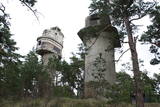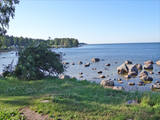| Нo | Название | Описание |
|---|---|---|
|
Посетители могут принять участие в копчении рыбы (камбала, а также сарган и лещ), отведать продукцию и послушать рассказ о традициях прибрежного рыболовства. В «Кроги» представлено примерно 20 видов заборов побережья, характерных для Берега ливов. |
||
|
Ilziņš jeb Vestienas dzirnavezers pazīstams ar nostāstiem par tajā "periodiski uzpeldošām kūdras salām". Saskaņā ar vietējo iedzīvotāju sniegtajām ziņām, minētā parādība gan sen jau vairs nav novērota. Tajā pat laikā ezers un tā apkārtne ir nozīmīga daudzu aizsargājamu biotopu un sugu dzīves vieta. Ezers ietilpst Vestienas aizsargājamo ainavu apvidū. Ezeru var redzēt, braucot pa Ērgļu - Gaiziņkalna ceļu. Var pakāpties arī blakus esošajā paugurā (ziemeļos no minētā ceļa un ezera), no kura paveras plašāka skatu perspektīva.
|
||
|
В северной части Лигатне - Гауясмале расположена единственная и функционирующая в наши дни переправа через Гаую и единственная переправа в Балтии, работающая на силе течения. Переправа - транспортное средство местного масштаба. |
||
|
Хозяйка гостиницы "Роя" приглашает на пир! Для улучшения самочувствия здесь гостей встречают музыкой и «Дзимтените», затем – уха на костре, застольные песни и танцы. Наблюдение за процессом копчения рыбы и потчевание, пиво и березовый сок. Рассказ жен рыбаков о скландрауши (дижрауши) и процессе их приготовления, а также короткий экскурс в профессию рыбака. Покушать можно в ресторане «Отра пусе». Латышская кухня: Свежая рыба «Утренний улов», луковый суп в латышском вкусе, букстиньш, кровяная колбаса, копченая рыба, картофельные блины, десерт из ржаного хлеба, пиво, «Дзимтените», травяной чай, березовый сок, яблочный сидр. Особое блюдо: «Сделано в Рое» – рыбное ассорти из продукции края, «Скумбрия в Bokzālēs», «Творожная башенка в соусе из свежей клубники».
|
||
|
Озеро Валгума – протяженностью до 3
км в длину и глубиной 27 м озеро
образовалось в субгляциальной рытвине
(ледниковое).
|
||
|
В хозяйственном здании Дубресского дворца можно наблюдать работы керамиста, самим попробовать изготовить керамику, заказать работы и приобрести сувениры из глины. Можно осмотреть дворцовый комплекс Дубрес, где сейчас (2013 г.) ведутся реставрационные работы. |
||
|
Arī 18. novembra laukums. Tas sācis veidoties 18. gadsimtā kā tirgus laukums. Tā dominantes bija 1752. g. celtais rātsnams (nav saglabājies) un aptieka, kas šajā ēkā darbojas no 1810. g. līdz pat mūsdienām. 2010. gadā laukumā izveidota strūklaka, kam ir pilsētas ģerboņa forma. |
||
|
Эту батарею проще всего найти, идя вдоль берега моря, так как одна из четырех позиций батареи находится на пляже – подмытая морскими волнами. Остальные позиции, телеметрическая вышка и другие элементы расположены недалеко от морского берега – в сосновом лесу. Батарея была построена в сороковых годах прошлого столетия. Отсюда уже видны Северные форты.
|
||
|
Дурбе - самый маленький город в Латвии со знаменитой историей, а также самый маленький город Латвии по численности населения (около 500 жителей). Дурбе упоминался уже в договоре 1230 года между куршами и Балдуином Альнским. В окрестностях Дурбе в 1260 году произошла знаменитая битва при Дурбе между объединенными силами Ливонского и Германского орденов и жемайшами, на сторону которых перешли курши, призванные в войско ордена. В Дурбе жил и работал один из первых садоводов Латвии Симанис Клевер (1834-1922). Благодаря ему в окрестных садах встречается много редких сортов яблонь. На гербе Дурбе, утвержденном в 1925 году, изображена серебряная яблоня. В окрестностях находится много хозяйств, специализирующихся на выращивании фруктов, и много активных садовников. Каждый сентябрь проводится праздник яблок. |
||
|
The viewing area is near the top of the Vilce castle hill, with a view of the Rukūze River valley, Zaķi meadow, and surrounding forests. This is an unusual landscape for the region of Zemgale. The Vilce baronial estate is nearby.
|
||
|
Route meanders between a rocky seacoast richly overgrown with reeds and other grasses on one side and wooded seaside dunes on the other side. In some places, the beach is paved with small round stones, in other places you can see grey dunes with a rich variety of plants. Near Bērzciems village, there are large coastal meadows with shoals appearing far away in the sea that are suited for birdwatching. During this route, it is possible to visit the fishermen’s homestead “Dieniņas”, where you can buy local smoked fish. Also it is worth to see Engure port and Engure Evangelical Lutheran Church. |
||
|
Saimniecība ir neliela un atrodas laukos, klusā vietā. Līdz ar to pilnīgi dabiski tiek nodrošināta mierīga un relaksējoša saskarsme un darbs ar zirgiem. Piedāvā izjādes ar diviem zirgiem, organizējam sacensības pajūgu braukšanā. Vasaras periodā nodrošina zirgiem pansiju. Atrodas tikai 4,5 km no valsts nozīmes A9 ceļa Rīga- Liepāja un 16 km attālumā no Rīgas Zoodārza filiāles „Cīruļi”. Vasarā ir ugunskura vieta, nakšņošanas iespējas teltīs. |
||
|
This trail offers education about the forest for children of all ages, families with children, and friends of the environment. The trail is located in the Īle Parish of the Auce Administrative District, 2 km from the Pokaiņu forest. |
||
|
Atrodas Skuķu ezera ziemeļaustrumu krastā. No torņa labi saskatāms aizaugušais Skuķu ezers ar nelielām ūdens lāmām un ūdeņiem bagātos pavasaros pārplūstošā Dvietes paliene. Laba putnu vērošanas vieta. |
||
|
This long tour of Latvia includes some of the best and most beautiful parts of Jūrtaka in Latvia. Hikes along the sea alternate with trips and excursions in the cities. You will go along the coast of the Baltic Sea from Mazirbe to Kolka, seeing Slītere National Park and Livonian villages. You will see Engure Nature Park and the overgrown seaside meadows that are suitable for bird watching. Along the way, you will be able to purchase smoked fish from local fishermen and learn about fishing traditions in Latvia. Further, the route will take you through the most popular seaside resort in Latvia, Jūrmala; you will also have time to visit the capital city - Rīga. The second part of the route runs along the Vidzeme coast from Saulkrasti to Svētciems. In terms of landscapes and views, the most multifaceted section of the Baltic Coastal Hiking Route in Latvia, which includes both sandy and rocky beach, coastal meadows, reeds, dunes, sandstone outcrops, forests, capes and small coves, fishing villages and pubs. |
||
|
Во время этого путешествия вы посетите как мастерские ремесленников, так и хозяйства по разведению лошадей, а также различные производства деревенских продуктов, где старинным навыкам нашлось современное применение. Первая остановка - Икшкиле, где уже в самом начале путешествия вы посетите погреб вина из березового сока и попробуете игристое вино из березового сока. В Скривери позвольте удивить себя превращениям молока - здесь, в уютном кафе на главной улице города, готовят великолепное домашнее мороженое как со вкусом клубники, так и со вкусом анчоусов и хрена. В Кокнесе вы сможете пополнить свой гардероб новым кожаным ремнем, сумкой или стильным украшением из кожи. В хозяйстве по выращиванию конопли пройдет небольшая экскурсия и дегустация деликатесов из конопли. Работы мастеров латгальской черной керамики хорошо впишутся и в современные интерьеры. В Аглонском музее хлеба посетителям будет предложена возможность самим испечь буханку хлеба, а во время посещения следующего хозяйства его можно будет дополнить вкусным сыром, который сделан из молока пасущейся на воле Латвийской бурой коровы. Последняя остановка на латвийской стороне - Даугавпилс, с Арт-центром имени всемирно известного абстракциониста Марка Ротко и Даугавпилсской крепостью 19-го века - впечатляющей военной постройкой - как наиболее популярными достопримечательностями. Затем дорога ведет в Литву, где запланировано посещение нескольких традиционных сельских хозяйств. В усадьбе Ильзенберга (Ilzenbergo Dvaras) обустроено биодинамическое хозяйство. Вы сможете попробовать национальное литовское кондитерское изделие – торт шакотис, осмотрите литовский город Аникщяй (Anyksciai), который предлагает прогулочную тропу над верхушками деревьев. В Музее лошадей представлены старинные орудия труда и техника. В продолжении предусмотрено посещение хозяйств, которые знакомят с традиционной литовской кухней и гончарным ремеслом. В коневодческом хозяйстве в Дубингяе (Dubingiai) можно прокатиться верхом на лошади по манежу. В завершении путешествия вы осмотрите уникальный Тракайский замок (14-15 век) и Вильнюс. |
||
|
Находится на обочине шоссе Мурьяни – Валка (A3) и легко узнаваема по строению и всевозможным сказочным образам, которые установлены во дворе корчмы. Латышская кухня: Супы (холодный свекольный, фасолевый, из кислой капусты, щавелевый), жареная свиная голень, кровяная колбаса, свиные ребрышки, ягодный кисель с хрустящими овсяными хлопьями, слойка из черного хлеба. Особое блюдо: «Огненный суп кухни ведьмы». |
||
|
In 1804 Käsmu founded the first Estonian naval school and from 1798 – 1920 built more than 40 ships. Now there is a museum about seafaring. |
||
|
Turbu dižozols aug Mazās Juglas stāvkrastā, atpūtas kompleksa Turbas teritorijā. Dižozols ir aptuveni 800 gadu vecs, tā apkārtmērs ir 7,1 m, augstums - 27 m, vainags 18x16 m. Dižozols ir ļoti labā stāvoklī. Zaļo viss vainags. Ozolā ligzdo pūce, kā arī iecienījuši daudzi citi putni. Zinātāji runā, ka Ozols ir ar spēcīgu dziedniecisku enerģiju. |
||
|
До наших дней почти полностью сохранился комплекс застройки господской усадьбы (> 12 строений) и парк. Замковая усадьба построена в 40 годах XIX века на довольно большом острове овальной формы, который со всех сторон окружен рвом. Такое расположение господского дома имитировало образец укрепленных замков средневековья. Сейчас в господском доме расположено волостное управление, библиотека и почта. Интересующиеся могут отправиться в познавательную экскурсию по усадьбе и ее ближайшим окрестностям. С Веселавской усадьбой связаны легенды о бароне и красивой девушке – Каусуле Расе, которая подобно Турайдской Розе не подчинилась прихоти помещика. Чтобы полностью услышать эту легенду, надо приехать в Веселаву. |
||
























